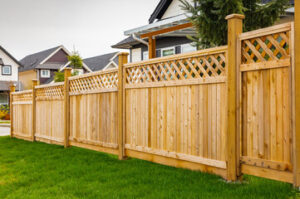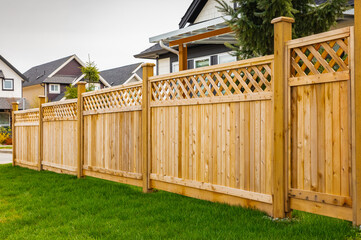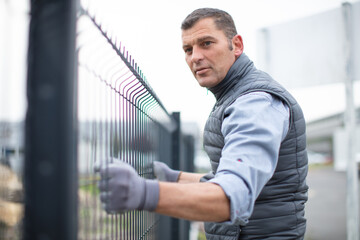Wooden fences add beauty to your property and keep pets and children safe from predators. They can also be a great way to protect your crops and gardens from wind damage. These fences can be made from a variety of materials and styles, including stockade, picket, lattice, shadow box, and post-and-rail.
The cost of a wooden fence depends on the type of wood used to construct it. Different species of wood have different properties, and some are more durable than others. Pine and spruce are inexpensive options, while cedar and black locust are more expensive. The price of a wooden fence can also vary depending on the area in which it is located. Homeowners should shop around for both materials and contractors to find the best deals on wooden fence installation.
The best way to reduce the cost of a wood fence is to buy the highest quality lumber possible. While this may mean paying a little more upfront, it will pay off in the long run. High-quality wood is less likely to warp or break than cheaply-made lumber, which can save homeowners money over time. Another way to cut down on costs is to avoid unnecessary add-ons. Some of these features, such as post caps and latticework, are not necessary and can make your fence more expensive than it needs to be.
Once the construction of your wooden fence is complete, it will need to be maintained and protected. A regular cleaning will help keep it looking good, while a periodic treatment with one of the best deck stains can protect the wood from the sun’s ultraviolet rays and repel water. Keeping up with this maintenance can extend the life of your wooden fence significantly.
Before you begin your fence construction, you will need to lay out the approximate fencing line and dig a hole that’s 18 to 24 inches deep for each post. This will ensure that the posts are secure and will not rot or become damaged by the elements. Once the holes are dug, they should be filled with concrete and leveled to ensure that your fence is straight and safe.
After the fence is constructed, you should consider putting in a gate to create a more formal entrance. A gate can be made of iron or wrought iron and will look great with wood fencing. While this is an additional expense, it can be worth the investment to protect your property from unwanted guests and enhance the aesthetic of your property.
Durability
Wooden fences can last for many years if they are constructed properly. However, they must be maintained and repaired regularly to prevent rot or insect infestation. They are also susceptible to damage from storms and other environmental factors. Different weather conditions can cause discoloration, moisture damage, and rot in wooden fences. Moreover, the weight of a fence can affect its structural integrity. It is important to check the durability of a wooden fence before buying it.
Depending on the type of wood used in your fence, you may need to apply a preservative to keep it durable and attractive. The most popular types of wood for fencing are cedar and redwood, which can resist rot and insects. These types of wood can be left untreated and will retain their natural color, but if you want them to last longer, you should consider applying a preservative every few years.
A wooden fence made from pressure-treated pine is another durable option. The treatment process adds chemicals that make the wood resistant to rot and termite infestation. It is also less likely to warp or shrink than other varieties of wood. However, if you plan to use a pressure-treated fence on your property, be sure to follow the manufacturer’s recommendations for maintenance.
Other materials, such as vinyl and aluminum, have a longer lifespan than wood, but they are still more expensive than a wooden fence. However, they require a lot less maintenance than wooden fences. These materials can be wiped down with a hose or pressure washer, which is much quicker and more efficient than sanding and painting.
When choosing a material for your fence, it is crucial to choose one that will be suitable for the climate and soil in your area. A tropical hardwood, such as cypress, is an excellent choice because it has the strength of redwood and resists rot and fungus. It is a more costly option than other types of wood, but it is worth the investment.
When constructing a wooden fence, it is important to use quality materials and professional installation services. If you do, you will get a beautiful, long-lasting fence that can improve the value of your home and increase privacy.
Appearance
Wooden fences can serve many purposes, including protecting a property from the elements. They are also a decorative feature. However, these structures must be maintained regularly in order to retain their appearance. This maintenance may include cleaning, repairing or replacing parts of the fence. In addition, regular staining is required to maintain the beauty of the wood. This helps to protect the wood against harmful UV rays and moisture.
In the past, people constructed their wooden fences by hand from individual boards attached to posts and rails. Today, many fences come prefabricated in panels, which simplify construction. This method has several advantages, including reducing the risk of splintering and warping. However, it can lead to a less uniform appearance for the fence.
If you are considering a wooden fence, it is important to consider the appearance and maintenance of the material before making a purchase. Different types of wood have different characteristics and will require different care. Cedar, for example, is a good choice because it is naturally resistant to insects and fungi. Its unique grain pattern makes it a beautiful choice for fencing, and it will remain attractive as it weathers. Oak wood, on the other hand, is a durable and versatile material that will stand up to the elements. Its light color features visible wavy grain notes, and it can last for hundreds of years.
Pine, another common option for a wood fence, can be stained to match your aesthetic. It is also available in a pressure-treated form that is resistant to insects and moisture. However, this kind of wood may discolor to a greenish hue over time.
Keeping your wooden fence clean is the best way to prevent damage. It is important to keep it free of leaves, twigs and other debris that can cause rot. A rotted wood fence will not only look unsightly but it may also attract insects that can cause further damage. Insect infestations should be addressed as soon as possible to avoid further damage.
To keep your wooden fence looking its best, you should regularly wash it with a cleaner that contains mildewcide. This will help prevent the build-up of mold and mildew, which can cause your fence to deteriorate over time.
Maintenance
Wood fences can be a stylish way to provide privacy and security for your home. However, they are susceptible to damage and require regular maintenance. This is especially important during winter, when snow buildup can strain the walls and lead to structural damage. During summer, it is also essential to protect wooden fences from sun damage. Wooden fences can be stained or painted to protect them from moisture and UV rays. It is a good idea to stain or paint your fence every few years, but be sure to follow the product instructions and allow sufficient dry time between applications.
One of the biggest threats to a wooden fence is moisture, which can lead to wet rot and mold growth. Fungus grows in damp environments and eats the cellulose, causing the wood to deteriorate. Additionally, fungus creates an ideal environment for other microorganisms to thrive, including mildew and some bacteria that can cause allergies in humans and pets.
Moisture damage can be prevented by minimizing water exposure and preventing moisture from gathering in cracks or crevices. This can be done by adjusting sprinklers so they don’t get the wall wet, and trimming trees or bushes that touch the wall. It is also a good idea to use a waterproof wood glue on any splits or small cracks.
If your fence has suffered damage from the weather, it is important to make repairs as soon as possible. This can prevent further deterioration and reduce the risk of insect infestations. If the damage is severe, you may need to replace the damaged section of the fence. If you have a metal fence, check for signs of rust and use a rust remover to clean the surface. It is also a good idea to install a gate to give your home a finished look and provide an entrance for guests and deliveries.
Choosing the right type of wood for your wooden fence is a crucial step in its longevity. Redwood and tropical hardwoods are the highest-cost options, but they offer superior durability. Other options include western red cedar and pine, which are more affordable.


 There are a few factors that determine the cost of metal fencing installation. The type of fencing material that is chosen is one important consideration. Iron fences, for example, typically cost more than aluminum. The height of the fence also impacts the overall cost. The number of gates and their style is another factor. For example, a 3-ft gate costs more to install than a 1-ft gate. The terrain where the fence will be installed is another factor. For instance, if the area is on a slope, installing the fence will require more labor.
There are a few factors that determine the cost of metal fencing installation. The type of fencing material that is chosen is one important consideration. Iron fences, for example, typically cost more than aluminum. The height of the fence also impacts the overall cost. The number of gates and their style is another factor. For example, a 3-ft gate costs more to install than a 1-ft gate. The terrain where the fence will be installed is another factor. For instance, if the area is on a slope, installing the fence will require more labor.